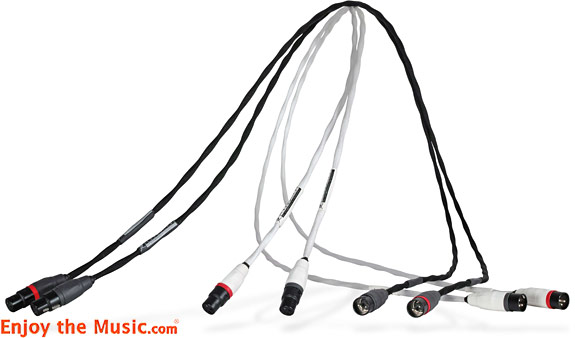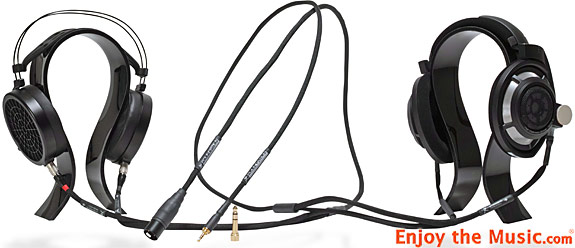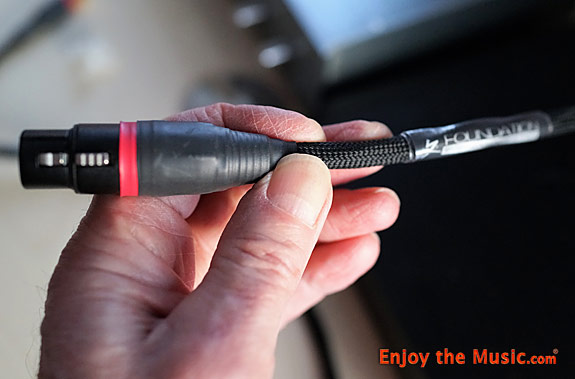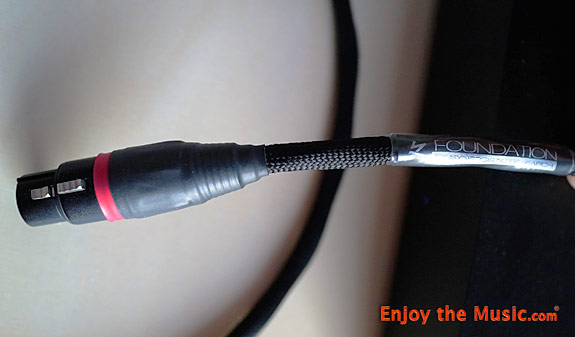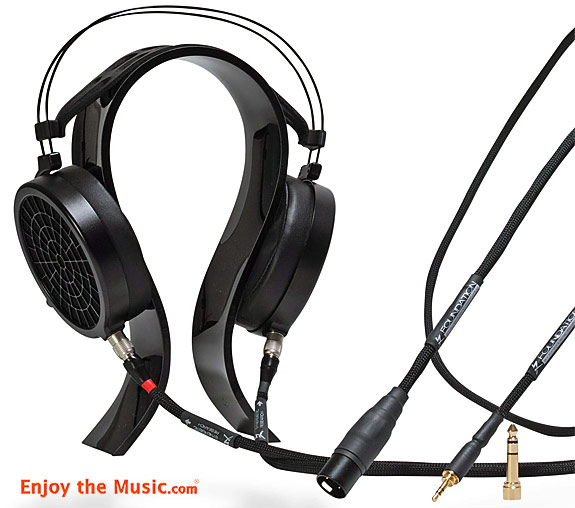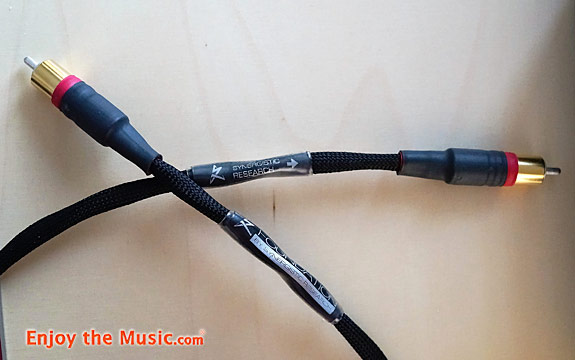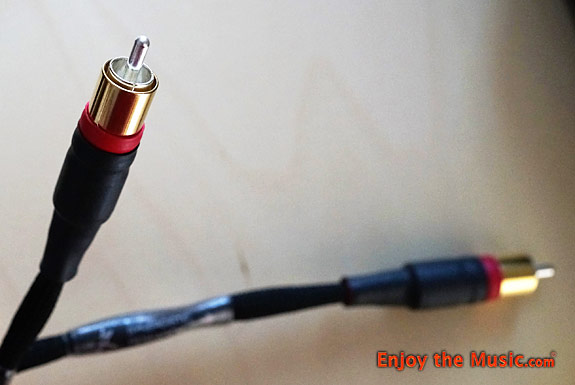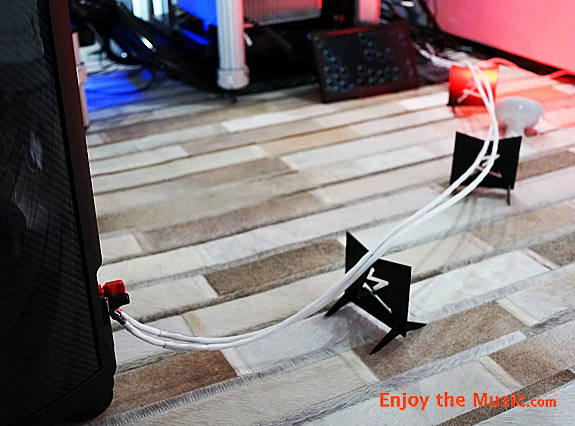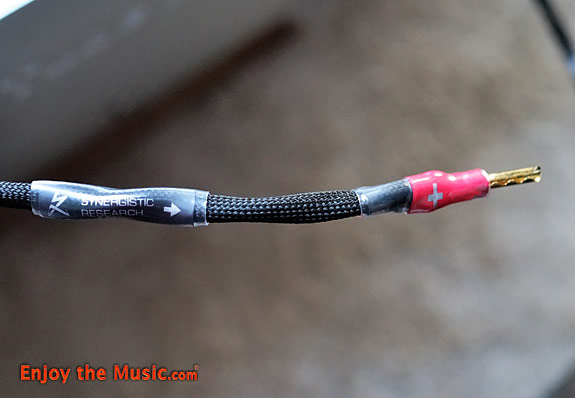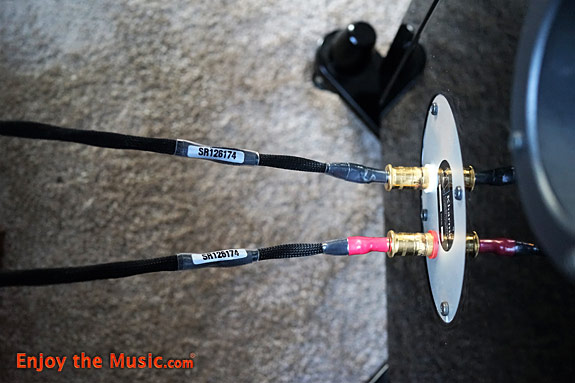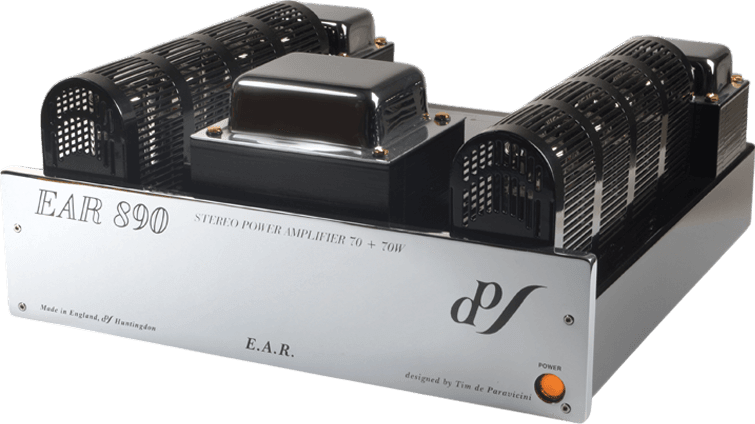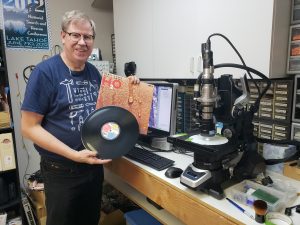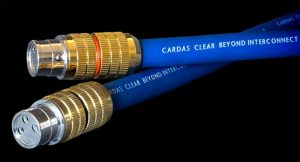Oracles house themselves within temples of the humble.
With this article, Positive Feedback continues its content-sharing relationship with Enjoy the Music. Rick Becker shares his thoughts about Synergistic Research's Foundation Cables.
Dr. David W. Robinson, Editor-in-Chief
Like with climate change, it's hard to believe there are still cable deniers in this world, but they show up in the forums with a loud voice. You would think the multitude of High End cable manufacturers would be a clue. After all, if high end cables were all snake oil, would so many companies exist? Would so many people buy them? And importantly, would brick and mortar stores, who build their reputations and depend on repeat customers, be selling them? At audio shows nobody runs generic power cords or interconnects.
Yet I can sympathize with the skeptics. How can something as simple as a high end power cord range in price from a hundred bucks to say $27,000? (Intentionally not naming names here.) Even Synergistic Research offers speaker cables and interconnects that range from a few hundred to many thousands of dollars. The answer, of course, is that they are not simple. Nor is the application of any given cable an appropriate value or reasonable purchase for every situation.
The key is, first of all, to try some cables to establish that they can make a significant difference with your gear. Then, the challenge becomes to find one that hits the "sweet spot," where the cost versus performance versus actually making the purchase falls within your comfort zone, or perhaps a little above. This is where the review of the new Foundation series of cables comes in. But first, a shout out to The Cable Company, who has a system for loaning cables that allows you to "try before you buy." Their charity drive for humanity each August easily justifies this mention in my mind. Check with your local dealer too, who may be willing to let you try cables over a weekend.
Don't trust any given review to tell you what cable is the absolute best (or even just the best value) for you to stick between any two components you own. I have no idea what your components are, or what level of performance you currently have achieved—or perhaps even more important, what level of performance you might be aiming for. Furthermore, "performance" includes your personal taste. Personally, I place high value on resolution, transparency, tonal color and PRAT (pace, rhythm, and timing). (I'm a tube guy, too.) Soundscape (left to right, and depth of stage), dynamics, and absolute fidelity to live musical instruments are only moderately important to me. Pinpoint imaging, and image height—much less so, though some of these attributes come hand in glove with others. Your values might be quite different than mine.
While a lot of guys pay homage to keeping their rig somewhat in balance in terms of quality among your components, that's easier said than done. I spent big bucks (relative to what I was earning, and relative to my other components) on my speakers many years ago, and to this day I still have not likely reached their full potential. Virtually everything in the rig has been upgraded at some point since buying the speakers, including an expensive equipment rack that wasn't even on my radar back then. Over the years I pieced together some very nice power cords, interconnects, and speaker cables from JPS Labs, Audio Sensibility, and some commercial interconnects from Kharma that purportedly had a mixture of silver and gold conductors.
I even replaced the stock hard wired power cords of some Sony ES components (CD player and tuner) with some generic shielded power cords. Eventually, I even upgraded the generic one on the tuner with a very impressive and cost effective power cord from Audio Sensibility that greatly increased my enjoyment of Hearts of Space on Sunday nights.
Caution: If you don't have trained experience, let a pro swap out your hard-wired power cords. If you don't anchor them properly, it can lead to deterioration of the cable casing and subsequent destruction to the component... and possibly worse!
Power Conditioners And Power Cords
There is also the issue of dedicated lines and power conditioners (as well as re-generators) to consider. The former I installed when I began reviewing equipment back in 2002, when I moved into my current residence. I installed a 30 Ampere JPS Labs In-Wall dedicated line for review, and a 20 Ampere Romex line for comparison. After a brief stint with a power conditioner during 2011, I added the first generation Synergistic Research PowerCell, a four-outlet version, along with some of their Tesla SE T3 active power cords. About this same time I experimented with a specially treated breaker from Synergistic Research that produced a modest, but noticeable improvement.
This treatment eventually evolved into what is now their UEF process that is incorporated in all their current power conditioners, making treated breakers an obsolete concept. In 2017 came the reviews of the Synergistic Research PowerCell 8 UEF SE and Atmosphere Level 2 and Level 3 Power Cords. Each of these products took my rig to a significantly higher level of performance, resulting in rave reviews. With this personal experience, combined with listening in their rooms at shows and other reviews in the press, it has become clear that Synergistic Research is one of the leading innovators in the high-end audio industry. Ted Denney, the owner and chief designer, has been on a mission, not just with cables and conditioners, but acoustic tweaks, room tuning devices, and as you probably know, even fuses.
Upgrade Path And Layout Considerations
Obviously, I am not a prolific cable reviewer, but do recognize a significant upgrade when I hear one. With my interconnects now 16+ years old, I began to wonder ("lust" might be more accurate) what the new Atmosphere (now Atmosphere X) series might add to my rig. In speaking with Andy Wiederspahn, Ted Denney's operations manager and right hand man, he suggested that people start first with their power supply — power cables and power conditioner—putting your best power cords on your sources, and stepping down a grade to power amps if necessary, from a financial standpoint. Once the power is upgraded, proceed to interconnects from the source(s) to the preamp (if you are using one). and then on to the amps.
And finally, to the speaker cables. Shorter cables are usually better than longer cables. But if your equipment layout requires longer cables, it is best to run long interconnects with shorter speaker cables, rather than the other way around. This is the way it is typically done at shows when long distances are employed. Personally, I keep everything relatively short. Only the interconnects from pre-to-power amps (two-meter) and speaker cables (8') are longer to accommodate variables when reviewing speakers and power amplifiers.
The Foundation Series
My audio life had been on "hold" for the past year and a half while I closed down my retail business and crashed into retirement. So it was very uplifting when Andy called and wanted me to review a full loom of their new Foundation Series of cables. For my rig, that entailed both balanced and single ended interconnects, and speaker cables that come as two separate single channel cables for each speaker—one positive, one negative. I specified banana ends on the speaker cables for the first time, and I found these to be a lot easier to use, given all the product swapping I do.
The series also includes phono cables with RCA, XLR, or DIN connectors, and headphone cables with four-pin XLR, 3.5mm (with 1/4" adapter) or dual three-pin XLR source connections. The headphone cables are available with 14 different connections for a wide variety of headphone brands. (Check the SR website HERE.) My Linn turntable has a captive phono cable, and I'm not really a headphone guy, so I didn't get involved with these latter two categories.
There is no digital cable in the Foundation Series, so I was sent a 1.5-meter RCA Atmosphere X Alive (Level 1), the next step up in the SR line. The Atmosphere X Alive uses the same conditioning and UEF Quantum technology as the Blue Quantum Fuses, so it is closely aligned with the Foundation Series. But unlike the Foundation series, the Atmosphere X Alive comes with a separate ground wire for the shield. I requested a 1.5-meter length for this digital cable, as I understand from a very reputable source that for S/PDIF applications, this length reduces the effect of signal reflections which contribute to jitter in digital signals.
There are no power cords listed in the Foundation Series because the Series is designed to go with Black UEF ($499) and Blue ($549) power cords already in their line-up. My original Atmosphere Level 2 and Level 3 power cords are priced considerably above the Black and Blue, but again, Synergistic recommends spending more for power cords and conditioning than on interconnects and speaker cables if your budget permits. I've followed their recommendation with excellent results.
Synergistic Research is shifting their marketing approach to encourage customers to purchase a full loom of cables from source to speaker to ensure that quality from the source is not lost in route to the speakers with an inferior cable somewhere in the chain. In my case, I had been using a hodgepodge of cables giving me a slightly different sound from each source (DAC, phono stage and tuner).
Construction
The Foundation Series is available in black or white jackets. I chose black because I like to listen in the "almost" dark, with just a small reading light at the listening chair. I had a chance to see and hear these cables in white at Rocky Mountain Audio Fest 2019 in early September, and the speaker cables looked very nice on the light colored carpet. Additionally, I thought the white would look good against a white wall behind an equipment rack where they would be less likely to trigger spousal cable phobia.
The overall look of the Foundation series is rather basic, but the construction is tight from tip to tip so they should hold up well for a couple of decades, at least. They are relatively thin, a little less thick than my little finger, which contributes to the flexibility and ease of threading them through a cable maze behind a rack. The outer jacket is tight and reveals the twisted cables within. Shrink wrap at the ends seems thick and tight. The cables are labeled nicely with the corporate name, model name, and serial number, as well as directional arrow and red/black bands to identify right/left channels. The XLR cables worked nicely, as you would expect, but the RCA connectors are non-locking types and are quite tight. I had to return the Atmosphere X Alive digital cable because I couldn't get it on my Calyx DAC.
Andy sent a replacement that seemed to have the identical connector, but this second cable went on with some effort. Better tight than loose, they say. Most of my other interconnects were much higher in price, and were equipped with locking RCA connectors. For someone who seldom swaps out components, the tight, non-locking RCA is a workable compromise that keeps the price more reasonable.
While the exterior is rather plain, the good stuff is on the inside. The conductors are 6N pure silver airstrings, four in the RCAs, six in the XLRs, routed in an air dielectric. The Foundation Series has a silver braided shield with Atmosphere Level 2 UEF Matrix Shielding, and a UEF coating with Graphene applied directly to the connectors. As I understand it, their Atmosphere Infinity towers (and satellites) and the new FEQ X4 will also work to enhance these Foundation Series cables.
Note that these towers generate an ultra-low frequency RF pulse that dithers the ambient RFI and EMI fields in the room. While the weave of the Foundation cables is not as complex as the fourth generation Tricon geometry found in the Atmosphere X Series above it, much of the technology of their higher line cables has been simplified and distilled down into the Foundation series. And they come at a price point where a whole lot more audiophiles can afford them while still maintaining the "house sound" for which the company is famous.
What is "House Sound?"
Some of the wise sages in the cable industry view the job of cables as simply to "get out of the way" of the music. We're all at the mercy of what's encoded on our vinyl and plastic discs, or stored or streamed in bits. Ultimately, the front end determines the maximum quality we can achieve in a system (setting aside the room and physical or electronic room treatments). Preamps, power amps, speaker crossovers and the cables that connect them all detract from (or color) the signal embedded in the recording or feed. Different cable manufacturers take different approaches to minimize the losses induced by cables. While they all pay attention to the purity of the conductor, some take it a step further to single crystal OCC conductors. Cryogenic treatment, cross section of the conductors, special shielding materials, and dielectrics all come into play in determining the "house sound" of each manufacturer.
Synergistic Research uses their special ultra-high voltage process in their UEF treatment, and in recent years has added a nano treatment originally developed for their Blue Fuse to their cable lines. Special weaves in an air dielectric also come into play with Synergistic. While the number of conductors and complexity of the weave in the Foundation Series has been cut back from their more expensive series, the basic concepts have remained, retaining the basic signature or "house sound" of their lead dog. A few years back they moved to a new factory and invested heavily in new equipment for application of the UEF treatment. With additional capacity they are now able to trickle down this technology to the higher volume Foundation Series.
We have also witnessed a relatively rapid turnover in their cable lines as their technology has advanced. This makes it frustrating for guys who are only able to acquire one cable at a time, leaving them to think their old cables are outdated. To address this, I borrowed an Atmosphere Level 2 unbalanced, 1m interconnect, Atmosphere Level 3 balanced, 1m interconnect, and a Level 2 speaker cable from my audio buddy Tom Lathrop, and swapped them in one cable at a time. While these cables are one series older than the current Atmosphere X cables, and originally more expensive than the Foundations, there wasn't much difference between them on short-term listening with my reference compilation CD. The balanced Atmosphere Level 3 was noticeably a bit better than the balanced Foundation interconnect, but not enough to spend the extra money on even a used version of this cable.
In my RMAF 2019 show report I mentioned that I noticed their room sounded not quite as good as what I heard some months earlier at AXPONA 2019. The difference was the white Foundation Series cables at RMAF. The difference in the cost of the cables alone at these two shows would pay for my entire rig with change left over to upgrade my daily driver. My takeaway from these two shows (both of which were rated among the Best Rooms at their respective shows) is the Foundation Series clearly retains the Synergistic Research house sound, and it's an incredible value. While you will not get the same results with your $10k rig as they did with the $200k rig at RMAF, it's nice to know you can turn your attention to other components or room treatments for a long time before you have to consider upgrading your cables... and who knows? The Foundations might well become your End Game.
So, What Did They Sound Like?
Some reviewers wax eloquently about the sound of cables. I'm not that kind of guy. To my point of view, cables don't sound like anything. They modify the signal in one or many ways depending on the components to which they are connected. They likely will also modify that signal between your components differently than the previous cables you were using. Some might mistake this as a quality of the cable itself. But ultimately the best they can do is pass on the signal they've been fed by adding as little distortion as possible. Speaker cables, being at the end of the chain, have to deal not only with the signal from the amp, but also the resistive load of the passive crossovers and the distortion that rises with additional complexity of these crossovers.
I can't say much about the burn-in except that sound quality bounced around for the first couple of days. After that, I was away for a week at RMAF 2019 while my wife tended to the music. When I returned, the rig sounded better, but pretty much the same. My components are not the most expensive, but they have been chosen wisely and the rig has been tweaked from the breaker box to the Soundeck IsoFeet under the speaker spikes. So, better in what way you ask. Resolution would be the key answer. Cognitive recognition of difficult lyrics was an immediate clue. Better definition of the notes including attack and decay. Smoother sustain on notes that were sustained. More inner detail, which led to a greater appreciation of room tone within the silences between musical notes.
Furthermore, increased resolution often leads to increased transparency along with enhanced tonal color and better soundstaging, and this happened, too. The treble got a little better and the base got a little better, but ultimately, these are functions of the electronics, not the cables. Being a tube guy, what I really treasure about music reproduction is a sense of space, and virtually everything I have in place or have tried in the past from Synergistic Research has enhanced the sense of real music recorded in real space. Obviously, this is especially true of 'live' recordings.
Proof of the primary importance of the component in determining the sound quality that occurred when I substituted the new AGD monoblocks with Gallium Nitride MOSFET based power stage into the rig. The changes were huge, but I'm going to hold off on the details as the review is forthcoming, soon. I will say, if you're looking to spend $7500, or even twice that, on a new amp, you may want to wait for this review. The point here is the Foundation cables not only fed the amp an excellent signal, but the speaker cables transmitted and revealed the excellent signal of the AGD amp. All of the great musical qualities that existed before, plus a bunch of new ones, were taken to a whole new level. I was forced to ask myself if I truly needed more expensive cables than the Foundations. If your ego, or your budget, clamor for something more elegant looking, you can move up the Synergistic line. Be aware you may have passed the cost effective sweet spot in their catalog. Diminishing returns and all that. You know the story.
Caveat Time
The one instance where the Foundations failed to impress me was in listening to Hearts of Space on NPR. This is often mostly electronic music with the theme of "Slow music for fast times." Normally, it is ethereal music that allows me to meditate and let my mind drift. I look forward to the show every week. The increase in resolution from the Synergistic Research Foundation interconnect brought too much resolution to the music, revealing the technical electronic nature of the music, which I found distracting. I'll have to dumb down my tuner by reversing the Synergistic MiG dome footers for more ambient sound, or remove them altogether. But when WXXI reverted to their classical music format the Foundations took me right to the concert hall. I can't complain about that.
Stepping back for a more global listen to the music, the gestalt of Synergistic Research's Foundation cables is the greater presence of the music. Not presence in the sense of a boosted upper midrange or presence region, but of being more present to the music. I found myself paying more attention to the music, and less inclined to multi-task. The trade journals piled up on the chair next to me, unread. Listening took the form of paying more attention to the actual music, or of letting the music move me by stimulating memories or fantasies. The equipment was in the room and pleasant to look at, but I didn't revert to analyzing the gear or the music. Basically, I repeatedly slipped out of "reviewer mode" and enjoyed the music. Perhaps I should have upgraded my cables a long time ago, or maybe I just got lucky and these are the right cables at the right time.
Summary
At this point within the evolution of high-end audio's cable industry, it is becoming a mature sector with a handful of companies (maybe two handfuls) capable of funding the research necessary to make substantive advances. There are also smaller companies that offer high value using more tried and true technology that force the Big Guys to trickle down their higher technology to remain competitive at more popular price points.
Synergistic Research is clearly on the cutting edge with their flagship Galileo line and new SRX power cable. The new Foundation Series cables are ample evidence of trickle down technology designed to capture new customers at price points where a lot of audiophiles call home. Dressing my gear with a complete loom from sources to speakers produced a consistency of sound among the different sources, and easily revealed the differences when other components were swapped into the rig.
If you're moving up from entry level cables, Synergistic Research's Foundation Series should be a very worthwhile improvement. And if you're already invested in higher line Synergistic cables and want to add a more peripheral component such as a cassette deck, AM/FM tuner, or video sound, their Foundation series will blend right in with what you already have. I was skeptical that the Foundation cables would make such an improvement in my system, yet they have replaced cables that cost far more, and taken my music far higher. Combined with a handful of their fabulous Orange Fuses, a $2000 to $3000 investment toward Synergistic Research's Foundation cables has taken my mid-five-figure rig well into six-figure territory. That's real value and an admirable feat!
Synergistic Research Foundation Cables
Interconnect: $599/1m Pair - RCA / XLR ($115 per additional 0.5meter)
Speaker Cable: $649/8ft pair, $70 per additional ft.
All cables available in Black and White
Not reviewed:
Phono Cables: RCA $699/1m pair ($135 per additional 0.5meter)
XLR or DIN $799/1m pair ($145 per additional 0.5meter)
Headphone Cables: $399/1m ($50 per additional 0.5 meter). Additional $100 for Dual three pin XLR
All cables are available in Black and White.
Synergistic Research
1736 East Borchard Avenue
Santa Ana, CA 92705
949.476.0000
Check out Enjoy the Music for more articles and reviews




